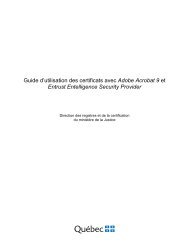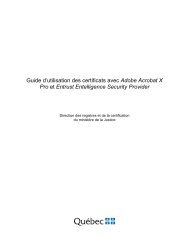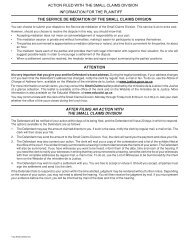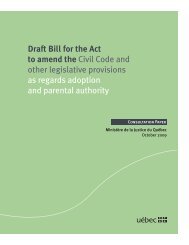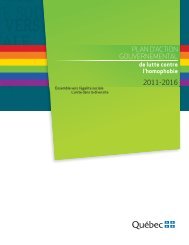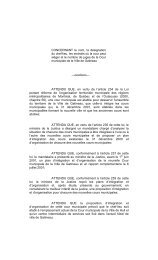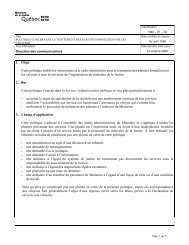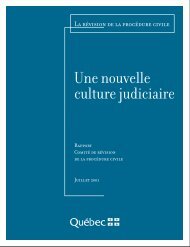guide on drafting court reports for use by certified addiction ...
guide on drafting court reports for use by certified addiction ...
guide on drafting court reports for use by certified addiction ...
Create successful ePaper yourself
Turn your PDF publications into a flip-book with our unique Google optimized e-Paper software.
ADDICTION TREATMENT PROGRAM OF THE COURT OF QUÉBEC (PROGRAMME DE TRAITEMENTDE LA TOXICOMANIE DE LA COUR DU QUÉBEC, OR PTTCQ)residence, state of health (medicati<strong>on</strong> and medical supervisi<strong>on</strong>), medical history(physical and mental health), suicide attempts (dates and circumstances) or not,and specialized treatment (current and past).3. PERSONAL AND SUBSTANCE USE HISTORYThis secti<strong>on</strong> must describe the key events in the offender’s pers<strong>on</strong>al history. It isdesigned to summarize the psycho-social elements that are relevant tounderstanding the offender’s substance <strong>use</strong> profile. It is important to c<strong>on</strong>centrate<strong>on</strong> elements c<strong>on</strong>nected with the offender’s addicti<strong>on</strong> that influence his or her pastor present substance <strong>use</strong>.The analysis of the elements of this secti<strong>on</strong> is essential and must describe theoffender’s substance <strong>use</strong> profile and establish links between the psycho-socialelements and the <strong>use</strong> of drugs or alcohol.The substance <strong>use</strong> history must c<strong>on</strong>tain the following elements: age andcircumstances when substance <strong>use</strong> began, psychoactive substances <strong>use</strong>d,habitual <strong>use</strong>, circumstances of <strong>use</strong>, reas<strong>on</strong>s <strong>for</strong> <strong>use</strong>, supply, history of previoustreatment, previous therapy (nature, number, place), periods of abstinence,important or significant events.The IGT, or any other assessment tool provided <strong>by</strong> the CDC-IUD <strong>use</strong>d to assessa pers<strong>on</strong> applying <strong>for</strong> the program, c<strong>on</strong>tains data <strong>on</strong> offender’s pers<strong>on</strong>al andsubstance <strong>use</strong> history that can be included in this secti<strong>on</strong> of the report.4. RESULTS OF TREATMENT / RESIDENTAL PROGRAMThis secti<strong>on</strong> must detail the offender’s progress in the therapeutic program andhighlight significant changes observed since the start of treatment. It must focus<strong>on</strong> the offender’s progress through the program stages and the offender’sspecific situati<strong>on</strong>. Using examples, the offender’s participati<strong>on</strong> in the therapygroups must be illustrated, al<strong>on</strong>g with the offender’s behaviour at the resourceand degree of involvement in his or her interventi<strong>on</strong> plan.The report <strong>for</strong>m must have a space <strong>for</strong> each stage. For example, the c<strong>on</strong>tent <strong>for</strong>Stage 1 must be placed in space 5.1, the c<strong>on</strong>tent <strong>for</strong> Stage 2 in space 5.2, andso <strong>on</strong>. This allows the <strong>court</strong> to assess the offender’s progress through each stageand to refer to the in<strong>for</strong>mati<strong>on</strong> provided previously.In short, the following elements c<strong>on</strong>cerning the offender’s situati<strong>on</strong> must benoted: treatment stage, objectives of the stage, interventi<strong>on</strong> plan, priority needs,therapeutic activities, participati<strong>on</strong> in the program (nature and quality ofparticipati<strong>on</strong>), difficulties and improvements observed, learning acquired, sharing5.



